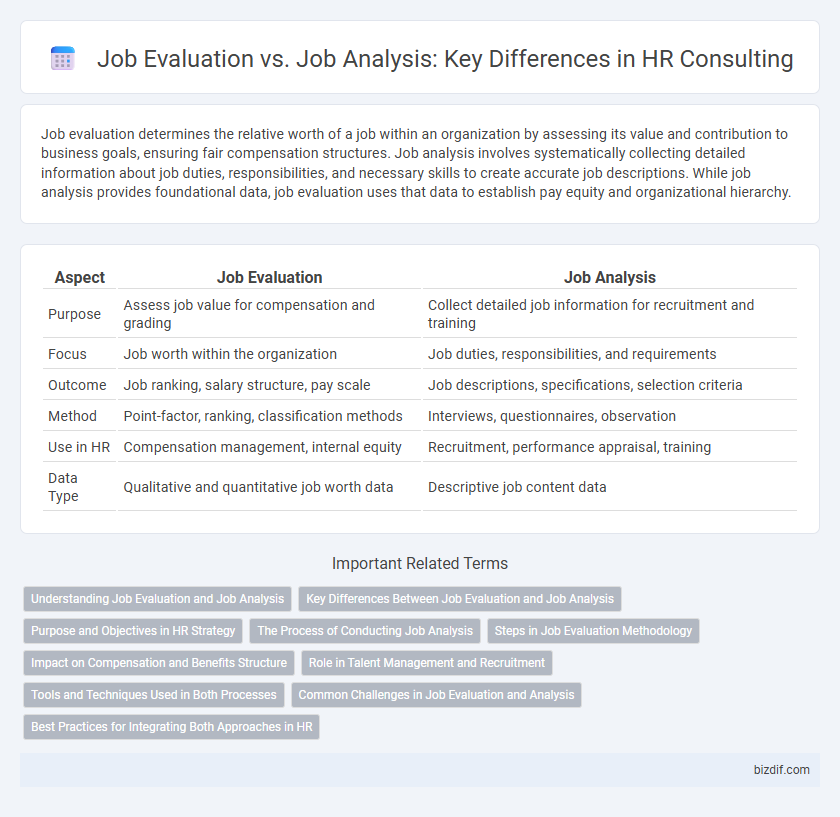Job evaluation determines the relative worth of a job within an organization by assessing its value and contribution to business goals, ensuring fair compensation structures. Job analysis involves systematically collecting detailed information about job duties, responsibilities, and necessary skills to create accurate job descriptions. While job analysis provides foundational data, job evaluation uses that data to establish pay equity and organizational hierarchy.
Table of Comparison
| Aspect | Job Evaluation | Job Analysis |
|---|---|---|
| Purpose | Assess job value for compensation and grading | Collect detailed job information for recruitment and training |
| Focus | Job worth within the organization | Job duties, responsibilities, and requirements |
| Outcome | Job ranking, salary structure, pay scale | Job descriptions, specifications, selection criteria |
| Method | Point-factor, ranking, classification methods | Interviews, questionnaires, observation |
| Use in HR | Compensation management, internal equity | Recruitment, performance appraisal, training |
| Data Type | Qualitative and quantitative job worth data | Descriptive job content data |
Understanding Job Evaluation and Job Analysis
Job evaluation systematically determines the relative worth of jobs within an organization to establish equitable pay structures, using methods such as point-factor, ranking, or classification systems. Job analysis involves collecting detailed information about job duties, responsibilities, necessary skills, and working conditions to create accurate job descriptions and specifications. Both processes enable HR professionals to align compensation and recruitment strategies effectively with organizational goals.
Key Differences Between Job Evaluation and Job Analysis
Job evaluation systematically determines the relative value of jobs within an organization to establish fair compensation structures, while job analysis focuses on collecting detailed information about job duties, responsibilities, and required qualifications. Job evaluation uses data such as job ranking, point-factor methods, and job classification to assess job worth, whereas job analysis employs techniques like interviews, questionnaires, and observation to gather task-based job content. The primary difference lies in job evaluation's focus on compensation hierarchy and job analysis's emphasis on job content and performance criteria.
Purpose and Objectives in HR Strategy
Job evaluation systematically determines the relative worth of jobs to establish fair compensation structures, aligning pay scales with market standards and internal equity. Job analysis collects detailed information about job duties, responsibilities, and required qualifications to support effective recruitment, training, and performance management. Both processes are foundational in HR strategy, ensuring workforce planning and compensation decisions optimize organizational effectiveness and employee satisfaction.
The Process of Conducting Job Analysis
Conducting job analysis involves systematically gathering detailed information on job duties, necessary skills, work environment, and employee responsibilities through methods such as interviews, observations, and questionnaires. This process creates a comprehensive job description that serves as the foundation for various HR functions including recruitment, training, and performance evaluation. Accurate job analysis enhances organizational alignment by clearly defining role expectations and competencies required for success.
Steps in Job Evaluation Methodology
The job evaluation methodology involves systematic steps including job analysis to collect detailed information about each role's responsibilities, skills, and requirements, followed by job description development. Next, jobs are compared using a chosen evaluation method, such as point-factor, ranking, or classification, to establish relative job values within the organization. The final step includes assigning pay grades or salary ranges based on the evaluated job worth, ensuring internal equity and external competitiveness.
Impact on Compensation and Benefits Structure
Job evaluation systematically determines the relative worth of jobs, directly influencing compensation levels and ensuring internal equity within the benefits structure. Job analysis gathers detailed information about job responsibilities and requirements, forming the foundation for creating accurate job descriptions that guide both compensation and benefits decisions. Integrating both processes supports competitive pay practices and benefits alignment, enhancing talent retention and organizational efficiency.
Role in Talent Management and Recruitment
Job evaluation and job analysis play distinct but complementary roles in talent management and recruitment by ensuring precise role definitions and appropriate compensation structures. Job analysis provides detailed insights into job duties and required competencies, serving as the foundation for recruitment criteria and role alignment within the organization. Job evaluation uses this data to establish fair and competitive salary grades, enhancing talent acquisition by promoting internal equity and motivating candidate engagement.
Tools and Techniques Used in Both Processes
Job evaluation employs point factor methods, ranking systems, and classification techniques to systematically assess job worth based on compensable factors such as skills, responsibilities, and working conditions. Job analysis utilizes tools like structured interviews, questionnaires, task inventories, and observation to gather detailed information about job duties, required competencies, and work environment. Both processes rely on data collection and analysis software to enhance accuracy and consistency in evaluating job roles for organizational effectiveness.
Common Challenges in Job Evaluation and Analysis
Job evaluation and job analysis frequently encounter challenges such as unclear role definitions, inconsistent data collection methods, and subjective rating biases, which can distort job value assessments. Ensuring accurate, comprehensive job descriptions and standardized evaluation criteria is critical to overcoming these obstacles and achieving fair compensation structures. Data reliability and stakeholder alignment remain essential for precise job analysis and effective job evaluation outcomes.
Best Practices for Integrating Both Approaches in HR
Effective HR strategies combine job analysis and job evaluation to align workforce capabilities with organizational goals. Job analysis provides detailed insights into job roles by identifying tasks, skills, and responsibilities, while job evaluation ranks these roles to establish fair compensation structures. Integrating both approaches enhances talent management by ensuring job designs are accurately assessed and rewarded, promoting internal equity and operational efficiency.
Job Evaluation vs Job Analysis Infographic

 bizdif.com
bizdif.com